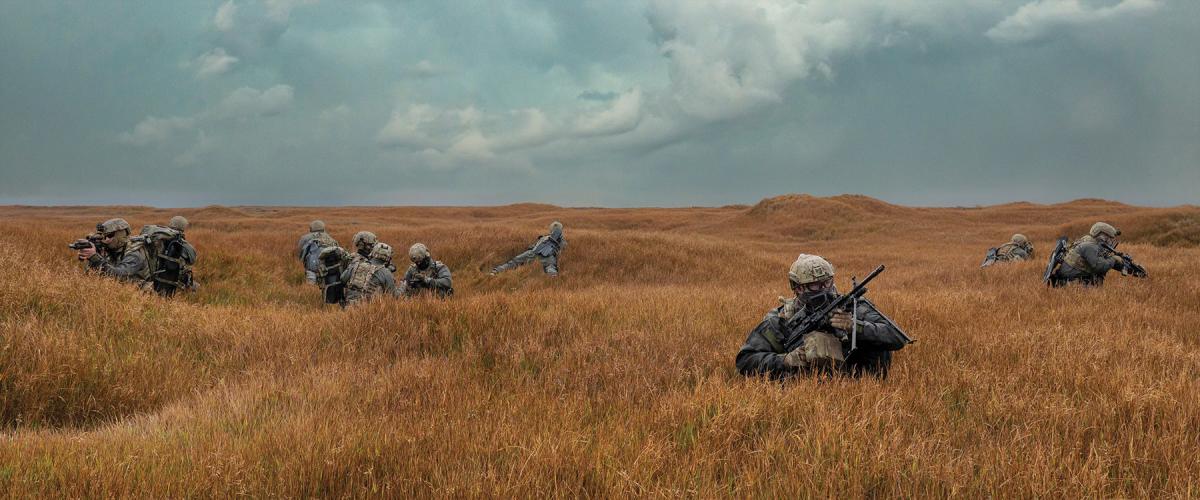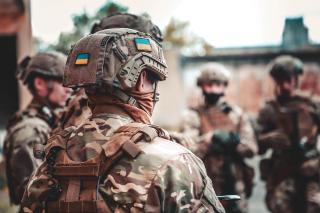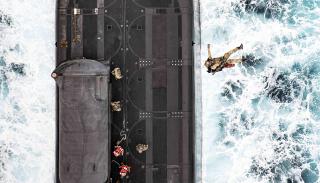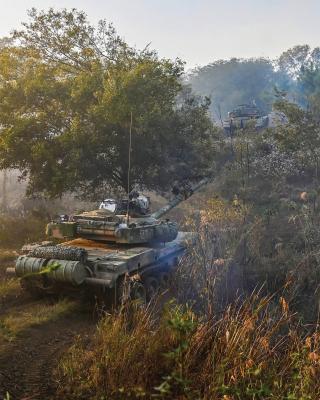Seth Cropsey

Naval Special Warfare is a crucial strategic tool for the U.S. military. Yet there has been remarkably little public thinking on the role special operations forces might play in a large-scale strategic confrontation. The War of 2026 scenario helps clarify the requirements for Naval Special Warfare (NSW) in such a conflict.
Two points need articulation. First, the revisionist coalition the United States and its allies face, primarily in Eurasia, has weak points; second, special operations forces (SOF) are the best tool to stress these weak points while ensuring high-end conventional assets are available for traditional engagements. These two arguments indicate a third, more profound reality: SOF can demonstrate the necessary link between the operational and the geopolitical in great power war—assuming it is properly resourced. This is true not only for NSW, but also for the broader SOF community.
SOF and Strategic Objectives

Romanian, Ukrainian, and U.S. special operations personnel conduct close-quarters battle training in Romania in May 2021. The most pervasive peacetime SOF mission today is training with U.S. allies and partners globally.
Special warfare is, by definition, odd. Anglo- American strategic historian Colin Gray once argued that special operations does not fit well into the United States’ political-military taxonomy. It is culturally, strategically, operationally, and tactically distinct from the traditional warfighting arms of any service. While NSW may fall under the Navy Department’s organizational chart, for example, SOF are naturally ground forces, and there will be friction between them and the traditional mechanized and armored forces that predominate.
Twenty years of counterinsurgency and counterterrorism transformed U.S. special operations from a niche discipline within a conventional military into a well-known, near-celebrity, almost standalone component of U.S. power. Joint Special Operations Command completely retooled itself during the 2000s and 2010s, becoming a force capable of prosecuting a strategic campaign against a mobile, adaptable, tenacious network of conventional and unconventional forces.
U.S. operators, whether NSW operators, Air Force Special Tactics Airmen, Army Special Forces (including 1st Special Forces Operational Detachment–Delta, sometimes referred to as “Delta Force”), or Marine Raiders, are extraordinarily well trained, disciplined, and effective soldiers, sailors, and airmen molded into small assault teams. Their light footprint makes them responsive, rapidly deployable, and capable of a breakneck operational tempo. But their transformation into a tactical entity that neutralizes high-value targets has become increasingly irrelevant since the early 2010s. And the cultural hangover from those missions and tactics inhibits strategy making. Special operations can only be retooled for a high-end fight if strategy and tactics can be linked through coherent operational design.
To begin, the entire special operations community, including NSW, should emphasize combined training and presence throughout Eurasia, building competence with potential and current U.S. allies as rapidly as possible. Indeed, its most pervasive peacetime mission today is training with U.S. allies and partners globally.
These limited interactions are useful, leading to some cultural familiarity that, during wartime, can prove the difference between a thrown-together but workable operational relationship and a disconnected coalition attempt. Anglo-American training missions in Ukraine, limited as they were, provided significant elements within the Ukrainian military with the tools and experience to beat back Russia’s initial offensive. They also created cultural familiarity between the British, American, and Ukrainian militaries that eased the first-aid shipments and enabled Ukraine to articulate its needs to the West more easily during the opening months of the war.
Unconventional forces can do more, however. Numerous examples from history show that special operations have a clear role in great power war. During World War II, to take just one, a daring raid by Italian divers on the British fleet in Alexandria, Egypt, in December 1941 disabled two Royal Navy battleships, giving Italy temporary naval supremacy in the Mediterranean.
Ukraine’s experience also is illustrative. During the war’s first year, Ukrainian SOF conducted several direct-action raids in occupied territory, likely operated within Russia, and worked closely with Ukrainian military and domestic intelligence to support saboteurs behind Russian lines. Ukrainian forces benefit from their natural bilingual talent pool—nearly the entire country speaks Russian and Ukrainian—increasing the deniability of Ukrainian external operations in Russia.
Ukraine’s talented spymaster and former special operator Kyrylo Budanov has constructed a coherent deep-strike campaign against Russian logistics and air defenses. As of this writing, the centralization of strike assets under special operations has allowed Ukraine to bottle up the Russian Black Sea Fleet in port despite having essentially no navy of its own, while also destroying multiple air-defense and ammunition sites in Crimea. Moreover, there are even rumors that Ukrainian special operators have deployed in limited numbers to Africa in an effort to undermine private military contractor Wagner’s presence abroad.
Ukraine has at times misused its special operations forces as assault infantry, although during the first few weeks of the war, they played a crucial role as night-fighting raiders conducting deep reconnaissance and harassment attacks against exposed enemy logistics. At present, however, it appears Ukraine has returned the assault infantry function to its airborne, marine, and newly constituted assault brigades, freeing SOF for other missions.
Special operations forces, then, have a role in high-end combat, even if the United States’ SOF community and political culture have generally forgotten how to use them in such a context. To remind U.S. strategists of the role they can play in great power war, it is necessary to identify the political drivers of this coming conflict and the probable adversaries to identify weak points for SOF exploitation.
Stress Fractures

East Coast–based Navy SEALs participate in a special operations interoperability exercise with the guided-missile submarine USS Florida (SSGN-728) and a U.S. Air Force CV-22 Osprey.
The United States confronts a revisionist coalition that in many ways resembles the one it faced in the 1930s and 1940s. China, Russia, Iran, and North Korea are the coalition’s most prominent members, with partners or satellites in Belarus, Venezuela, Cuba, Armenia, Cambodia, Myanmar, and South Africa. Brazil and Pakistan are potentially members, too. The coalition’s core states all chafe under the U.S.-led Eurasian security system and would like it dismantled in toto. Others may object only to part of the broader system despite their increasing alignment with the New Axis.
None of the major challengers have enough independent power to defeat the United States, particularly if it receives support from allies and friends. If each faces the United States independently, each is likely to fail, while a coordinated attempt among all four adversaries to fracture the Eurasian security system might well overload U.S. command and control while also compelling the United States to divert resources to different theaters, reducing its potential margin of superiority in any one.
If this hostile coalition coalesces, it would be very stressful for U.S. forces. At the same time, it would have three fundamental weaknesses. First, it would lack the ideological unity needed to mitigate built-in friction among its members. Second, contradictory interests undeniably exist, particularly between Russia and China, but also Russia and Iran. Third, despite a clear need for Sino-Russo-Iranian coordination, the distances involved make it difficult. Even if China could conclude a formal military alliance with Russia and Iran, long-distance coordination would be its greatest vulnerability. Consider that Imperial Japan never initiated conflict against the Soviet Union, despite that being Nazi Germany’s best hope to increase pressure on the Soviet Union’s broader strategic system, in part because distance encouraged Japan to take a more cautious approach.
The United States’ best chance of success in the War of 2026 would therefore be to disaggregate the Eurasian Axis coalition, reducing the threat to less than the sum of its parts. Exploiting its weaknesses to encourage that disaggregation would require a Eurasia-wide strategy. The choke points and littorals around Eurasia’s rim allow its regions and nations to trade. Hence, they are the prize, not the heartland itself.
Aircraft carriers, long-range bombers, and submarines would be essential to keep the People’s Liberation Army (PLA) bottled up in the first island chain and, ultimately, mount a counterstroke. Conventional air-land forces likewise would be needed to deter or defeat escalation in secondary theaters in Europe and the Middle East. U.S. forces can cope with this challenge, but every element must be properly engaged. Rapidly deployable and deniable assets also would be crucial to imposing costs and increasing stress on the adversary coalition. Here, SOF could serve a crucial supporting role for traditional forces.
Special Operations Missions

Tanks from the People’s Liberation Army in the jungle during a live-fire training exercise in October 2023. Naval Special Warfare would contribute to a great power fight less by confronting armor head on than by attacking the tanks’ logistic tails.
Seven operational lines of effort can connect to the above strategic objectives. These are organized in descending order of strategic value.
Exploitation of high-value targets in the first island chain: The War of 2026 scenario assumes China would not immediately accomplish all its objectives. This may result in a split decision on Taiwan, under which the PLA maintains a significant lodgment, but U.S. and Taiwanese forces prevent the island from falling. It may also include a situation in which Taiwan is under Chinese air-defense control, but the PLA cannot entirely cut off access to Japan, Korea, and the Philippines.
Regardless of the outcome in the first weeks of fighting, it is probable that both the PLA and the United States would take extensive losses. Great power wars are not merely long; they also include a “broken-backed” phase. The terms is traditionally associated with a stage of conflict that follows massive use of nuclear weapons. It applies in this case when the major powers would likely have taken heavy losses but nevertheless retained enough deployable forces to cause each other damage and achieve meaningful strategic objectives—all while rebuilding larger forces for another offensive in the coming months or years. Gains and losses in the broken-backed phase of a great power war can be decisive in the long run. Britain’s ability to hold Egypt and the Levant despite Axis pressure ensured the long-term coherence of the Western coalition, for example, while the Allied victory at Guadalcanal, despite its difficulties, provided invaluable supporting terrain for future campaigns.
It is thus enormously relevant for the United States to delay Chinese force regeneration by hitting as many ports, dry docks, airfields, and exposed air-naval infrastructure as possible after the first phase to help ensure the United States emerges from the broken-backed phase first. Ideally, the United States would create a strategic situation that either keeps PLA warships tethered to a specific base or splits the PLA Navy in half, enabling the United States to concentrate submarines and strike aircraft against a divided Chinese fleet.
NSW can aid this campaign by mapping, enabling, and, in certain circumstances, carrying out demolition missions against exposed targets. Similarly, there would be other Chinese bases scattered throughout and around the first island chain, such as Ream Naval Base in Cambodia or the PLA’s artificial islands, that could be used as naval bases and would be ripe for special operations targeting and sabotage.
Chinese rimland targets beyond the first island chain: China is well aware of the odds of a long war, even if it were to successfully take Taiwan in a matter of weeks. It has therefore constructed a military and economic pipeline that allows it to exert influence beyond the first island chain and provides it with alternative ports beyond the Malacca and Lombok Straits. These include wholly or partly owned ports in Dhaka, Bangladesh; Gwadar, Pakistan; and Hambantota, Sri Lanka. They also include overseas military bases. Currently, China’s only such base is in Djibouti, but there is potential for others.
The strategy of the New Axis would be to compel the United States to split its resources among theaters, driving overall capabilities below an economy-of-force defensive threshold. This would thereby enable a serious strategic reversal in Europe, Asia, or the Middle East that would push the whole defensive system off balance. The U.S. strategy should be to do something similar by seeking to force the New Axis to commit forces beyond its means.
Most critically, that would require turning China’s port network—sometimes referred to as the String of Pearls—into a noose. This is an ideal sabotage mission for NSW. It is a low-footprint, high-tempo mission that would deny a safe harbor to any Chinese warships beyond Malacca and Lombok. Equally relevant, by disrupting port access, this series of attacks could slowly undermine Chinese power and capacity.
Disruption of New Axis links: The New Axis’s greatest coordination advantage would come from its lines of communication in the Eurasian interior, rather than relying wholly on the littoral for operations and supply. Exploiting that advantage demands vulnerable pipelines, energy and matériel storage facilities, rail and road links, satellite connections, and, potentially, even joint military bases. In general, one might conceive of the relationship as circular. Iran and Russia need Chinese consumer electronics and, in the future, even weapons. China can transport these by sea, but overland routes to Russia using the Sino-Russian border or Central Asia are more insulated from U.S. naval power. Russia and Iran, in return, can export oil and gas to China, both through overland pipelines and dark tankers to secondary ports.
The United States has a strategic interest, first, in curtailing or eliminating as much Russian and Iranian maritime traffic as possible and, second, disrupting the interior linkages. Special operations forces could accomplish both goals, the former through a sabotage campaign against major enemy ports, and the latter through a long-term, direct-action campaign that targets infrastructure in third-party countries. Even without the necessary basing agreements from regional partners, NSW is rapidly deployable. It also is deniable enough to make a relationship with India possible, despite New Delhi’s continued anxiety over confrontation with China.
Commercial disruption: Commerce raiding would be a crucial part of this war for both parties, but particularly for the United States. China dominates the global shipping market by design. As rates skyrocket and flags of convenience become unreliable, Chinese ships would probe any U.S. blockade. It would almost certainly be a waste of resources to use submarines as commerce raiders in a modern naval war, particularly because, unless the current shortfall in submarines is reversed, the U.S. Navy would have only a few dozen for operations in the western Pacific. (See Toti, “You Can’t Win without [More] Submarines,” December 2023, pp. 38–45.) However, a combination of NSW and light warships (such as littoral combat ships) could police the approaches to the straits and disrupt Chinese shipping.
Activity beyond Eurasia: China would undoubtedly encourage actors beyond the core of the New Axis to make strategic trouble for the United States, much as the Soviets sought to do in Latin America and Africa. Venezuela, Cuba, and South Africa come to mind as trouble-making secondary powers. North Korea, in particular, could be considered one as well, were it to spark a crisis on the Korean Peninsula that drew U.S. forces into Chinese missile range.
Frontline U.S. combat units would be at a premium during the War of 2026. Contingencies in tertiary theaters probably would be met only with ad hoc assemblies of units on hand, akin to the British response at the start of the Falklands War. SOF would be crucial in these instances, particularly if the United States seeks to conduct any open-ended, small-war-style suppression or to support friendly governments against Russian-, Chinese-, or Iranian-backed insurgencies.
Support for Taiwanese forces: The fate of Taiwan in a major conflict’s opening weeks is a crucial strategic question and a central moral consideration. In a split decision, under which China holds a major port in Taiwan but lacks full control of the island, NSW and Marine Special Operations Forces (MarSOF) could lead sabotage missions against PLA offloading facilities and occupied ports. If China did hold the island, NSW, MarSOF, or other SOF units could fight as guerrillas and embed with Taiwanese forces to increase their combat power.
The United States’ space-based ISR system is likely to come under severe stress in a major-power war. (See Brown, “The Challenge of Joint Space Operations,” January 2024, pp. 28–35.) Providing SEALs and Marines on Taiwan with a robust terrestrial ISR system that could be rapidly deployed with a light footprint would allow them to cue missiles fired by U.S. warships, aircraft, and submarines at range.
Support for other occupied forces: An Indo-Pacific war is unlikely to remain geographically restricted to Taiwan or be limited to Taiwan, the United States, and China as belligerents. It would likely broaden rapidly to include direct attacks on Japan, alongside activity in Indochina and potentially the Philippines, as well as along the Korean peninsula. U.S. SOF must be prepared to deploy rapidly in support of national militaries and post-assault insurgencies throughout the Eurasian rimland, to both attrit Chinese forces and engage Chinese assets that otherwise could be held in reserve as that country attempts to expand beyond the first island chain.
All these missions require additional funding. But more relevant than the funding itself would be three crucial changes from recent history. First, SOF would need to become far more comfortable with fighting absent rapid strategic mobility, a capability that could be assumed in the global war on terror. Second, SOF would lack robust, consistent, reliable communications with command elements. This would require individual teams to have some strategic understanding of the situation before they deploy, should they be cut off from command guidance but nevertheless need to make crucial operational decisions. Third, SOF would not receive the kind of follow-on support to which it has become accustomed. Air support would be infrequent at best and impossible on certain missions. Follow-on forces for extraction also would be difficult to organize. This would generate an emphasis on speed, effective infiltration, planning, and carefully targeted objectives.
Austere Technology
To be able to carry these missions out in the War of 2026 will require four investments today in technology and adjustments to NSW and SOF practices and structures.
First, the United States must develop new supporting technology for offensively minded NSW and other SOF missions. Conducting distributed operations throughout the Eurasian rimland—and in the interior when possible—will demand clandestine insertion and extraction. A large-scale StarLink-style array of communication and imaging satellites should provide some redundancy for deployed NSW units, while encrypted one-way communication systems would bolster NSW’s ability to gain strategic direction from higher-level headquarters. Logistics and resupply also are central. The United States should invest in a fleet of long-range, medium-payload unmanned aerial vehicles that can fly under their own power to and from the remote operating sites of NSW units.
Second, the United States should invest in a variety of new weapons and organic sensors for NSW units as they insert into enemy territory, as well as some that can be provided quickly and cheaply at standoff range. These include long-range, low-payload loitering munitions, akin to what Russia and Ukraine have employed since mid-2022. Combined with a small footprint, battery-powered ISR unmanned aerial system, this should allow NSW units to apply significant firepower independently, even without ship-based fire support. Moreover, SOF could employ a cueing system that relies on attritable space-based communications to employ a limited number of stand-off weapons, likely stealth cruise missiles.
Third, the United States will need to develop a battle management system that supports these long-range strikes, especially for battle damage assessment. NSW units can be part of a network for post-strike data collection, but there must be some sort of unidirectional communication link between units and headquarters to provide forces on the ground information about the broader operational situation.
Fourth, the SOF community should reconceptualize at least some of its elements for offensive maneuver. SEAL teams should be assigned geographical mission areas and deploy forward, with perhaps half of NSW’s SEAL teams abroad. The other SOF within Special Operations Command should consider breaking their units into company and platoon-sized ones, akin to the NSW model, and deploying them in a similar fashion.
Geopolitical to Operational
More important than hypothetical missions is a fundamental issue: The U.S. military and the policy establishment have had a “strategy problem” for multiple generations. Policy-makers have ceded to military leaders an enormous amount of political authority within ostensibly military tasks, while military leaders have abdicated their responsibility to understand political conditions and retreated to apoliticization to justify their disengagement.
This approach is wholly incompatible with a major power war, as it short-circuits the U.S. strategic apparatus’s ability to coherently grasp the stakes it faces.
SOF are the only element of the U.S. military based solely on economy of force. By reducing mass to such an enormous degree, SOF accrue advantages in deception and surprise that translate into shock. This allows small, highly trained teams of operators to accomplish their mission despite overwhelmingly firepower inferiority.
The nimble nature of SOF and the scale of the missions that great power war would demand indicate a need for a coherent linkage between geopolitics and operational planning in a manner far more fundamental than has been considered in the SOF community since at least the Vietnam War. The result should be an intellectual transformation in naval and military-wide special operations that embraces the need to plan for a truly Eurasian fight. In the long war, NSW’s unique talents could prove decisive if they are employed with coherent strategic skill.
No comments:
Post a Comment